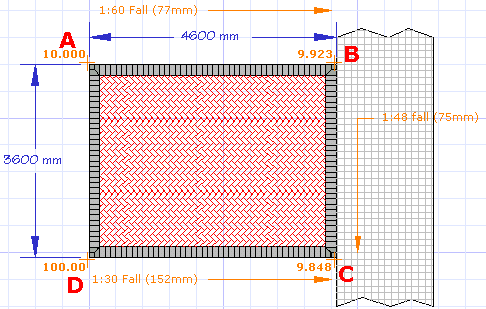Your paving doesn't have to be a flat plane: it can 'twist' to tie-in perfectly with the public pavement, no problem at all.
You state that it's 15ft long, which is roughly 4.6m (it
is the 21st Century!!). So, allowing a fall of 1:60 (roughly 17mm fall per linear metre), the fall from the 'back' of the drive would be 4.6m X 1/60 = 77mm. On the drawing below, I've shown this as the high point (A) having a datum level of 10.000 and so, with 77mm fall, the level at the footpath (B) is 9.923.
Then, as you state, there is 3inches (75mm) of fall across the width of the drive (between B+C) so this gives us a level at C of 9.923-0.075 = 9.848, which, as shown on the drawing, is a crossfall of roughly 1:48.
This then means there is an increased fall from D to C of 152mm, which is about 1:30.

Lay your soldier edgings on concrete using taut string lines to guide line and level, as described on the
Laying Edges page. At the threshold with the pavement, lay your soldier edges to the best line possible, disregarding any minor variation in level of the public footpath. Some contractors like to lay 50-150mm back from the edge of the public footpath and then infill the gap with repair macadam or a concrete fillet to take up any minor differences.
The back edge of the drive (A-D) is laid as required, and then the sides (A-B and C-D) can be laid to tie in as required. You then screed off your bedding layer using a notched screeder board. The plane of the bedding layer will 'twist' as it moves down the drive towards the public footpath, but block paving is more than capable of dealing with such a minor twist with no noticeable effect on the jointing. Honestly!
Once the bed is screeded, lay the blocks, cut-in, sand and wacker and then you can have a pint. :)
